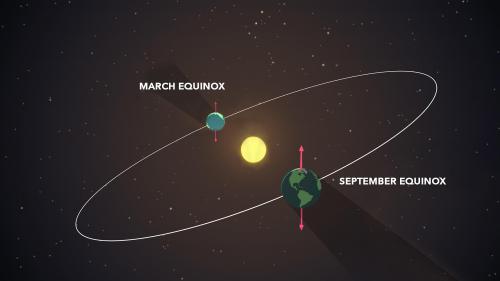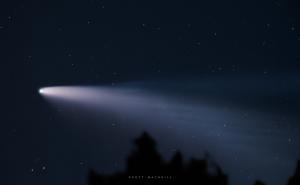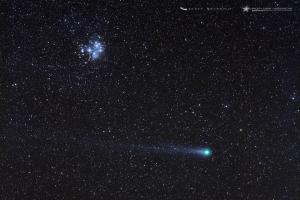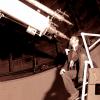Celebration of Space - September 20, 2024
On Sunday, September 22, 2024 at 8:44 am ET, Earth will reach the point in its orbit where we are neither tilted towards or away from the Sun. This is called the Autumnal Equinox, and hails the start of the fall season in the Northern Hemisphere. On the Equinox, those who live along Earth’s equator will experience the Sun rising due east, passing directly overhead (zenith) at noon, and setting due west, allowing for nearly equal duration of day and night times worldwide. Since we are neither tilted towards or away from the Sun, sunrise and sunset times will be the same for corresponding locations in the Northern and Southern hemispheres. The Autumnal Equinox also signals a shift in day and night duration to the part of the year with longer nights than days in the Northern Hemisphere. All that aside, this celestial happening calls in the autumn season in the Northern Hemisphere and with it comes beautiful fall colors, harvest festivals, Oktoberfest, pumpkin pie, spooky décor, maniacal leaf-peeping, lunar halos, the Andromeda Galaxy, and the inevitable dive into shorter days with cooler temps. So step out on the morning of the 22nd and welcome the start of the autumn season and all the amazing trappings that come with it.
Comet C/2024 A3 Tsuchinshan-ATLAS (Comet A3), a comet with exceptional visibility expectations, is being buried in all this news lately about the new mini-Moon, which is somewhat silly in that the object, 2024 PT5, is so small and dim that you would need an incredibly dark location and a telescope larger than the 24 inch primary observatory telescope at Frosty Drew to actually see the object visibly, which would only look like a tiny star. Instead of paying attention to all the hype about 2024 PT5, which you just won’t see, start gearing up for potentially stunning naked eye views of Comet A3 in the coming days.
Starting on the morning of September 27, 2024, at around 5:45 am, Comet A3 should be easily visible over the eastern horizon, potentially to the naked eye. The view will continue until around October 6, 2024, after which we will lose it again to the Sun, but only for about a week. Starting on October 12, 2024, Comet A3 will move into the evening sky just over the western horizon, rising higher and staying out later with each passing night. Naked eye visibility should continue well into late October 2024.
Comet A3 is a long period Oort Cloud comet, with an orbital period of over a million years. On September 27, 2024, the comet will reach perihelion, which is its closest approach to the Sun, at a distance of 36,345,721miles from the Sun. On October 12, 2024, the comet will make its closest approach to Earth at a distance of 43,689,000 miles. How bright a comet will get is always a matter of debate, and predicting the brightness of a comet is notoriously difficult. As of today, predictions in brightness are focused on the October viewing periods in the evening sky and range from magnitude 1.2 to -4. For reference, the bright star Sirius has a visual magnitude of -1.46, the Sun has a visual magnitude of -26.7, and Polaris (the North Star) has a visual magnitude of 2. Note that the smaller the magnitude, the brighter the object is. At Frosty Drew, we usually side with the more conservative predictions in comet brightness, as this is usually how the view will play out. But even at magnitude 1.2, the comet will be fantastic.
To see the comet, grab your binoculars and/or even a small telescope, and set out to a location with a very low view of the eastern horizon, somewhere like Point Judith, RI, and be there for 5:30 am starting on September 27th. The comet may be visible to the naked eye if the sky is clear enough, but it should be visible in binoculars. Though the best views are set up for October, and if the comet is rocking socks, we will post finder charts to aid in finding the comet in the evening sky.
Now that both the International Space Station (ISS) and China’s space station (Tiangong) have returned to the evening sky, family friendly viewing opportunities abound. We say “family friendly” because the timings of visible passes are during a window when most families are at home and still awake. To catch a view of the stations, all one needs to do is look up at the right time, as the stations are quite bright when they visibly pass over. Here are several notable sighting opportunities for the coming evenings:
ISS:
Fri, Sep 20 at 7:22 pm, starting in the NW, rising to 16°m heading towards the NNE.
Sat, Sep 21 at 8:12 pm, starting in the NNW, rising to 15°, heading towards the NNE, and into orbital sunset
Sun, Sep 22 at 9:00 pm, starting in the NNW, rising to 18°, and into orbital sunset
Mon, Sep 23 at 8:12 pm, starting in the NNW, rising to 19°, and into orbital sunset
Tue, Sep 24 at 7:25 pm, starting in the NNW, rising to 16°, heading towards the NE
Wed, Sep 25 at 8:13 pm, starting in the NW, rising to 32°, and into orbital sunset
Thu, Sep 26 at 7:25 pm, starting in the NW, rising to 24°, heading towards the ENE, and into orbital sunset.
Tiangong:
Fri, Sep 20 at 8:14 pm, starting in the WSW, rising to 76°, and into orbital sunset. ← Awesome pass!
Sat, Sep 21 at 7:11 pm, starting in the WSW, rising to 53°, heading towards the E
Sun, Sep 22 at 7:44 pm, starting in the W, rising to 88°, heading towards the E, and into orbital sunset ← Awesome pass!
Mon, Sep 23 at 8:18 pm, starting in the W, rising to 83°, and into orbital sunset ← Awesome pass!
Tue, Sep 24 at 7:15 pm, starting in the W, rising to 86°, heading towards the E, and into orbital sunset ← Awesome pass!
Wed, Sep 25 at 7:48 pm, starting in the W, rising to 81°, heading towards the ESE, and into orbital sunset ← Awesome pass!
Thu, Sep 26 at 8:22 pm, starting in the W, rising to 39°, and into orbital sunset.
Look at all those awesome passes of Tiangong! Put these times on your calendar and set your alarms. For daily pass times of the stations and other bright satellites, visit the Frosty Drew Daily Satellite Prediction Utility. Now get out there and check out humanity’s only space based residences passing over hundreds of miles up.
- Author:
- Scott MacNeill
- Entry Date:
- Sep 20, 2024
- Published Under:
- Scott MacNeill's Columns





